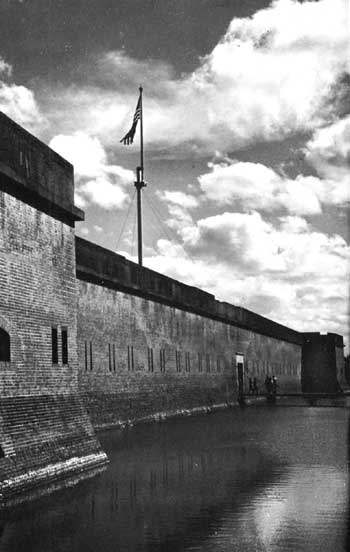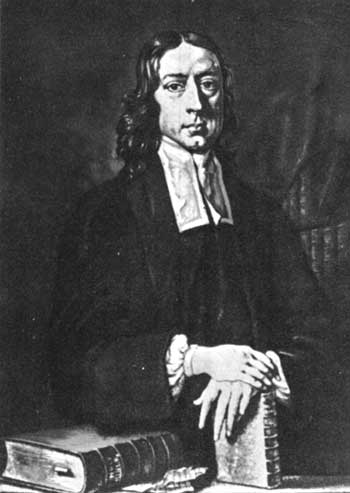|
FORT PULASKI National Monument |
 |

The walls and moat of Fort Pulaski,
Photo by Franklin Dulany.
FROM THE DAWN OF HISTORY to the present, men have labored unceasingly to surround their homes with impregnable fortifications while at the same time they have tried to discover more powerful weapons to smash through the defenses of other men. The Romans and the Chinese had their great walls; the feudal lords of the Middle Ages had their moated castles; and to modern times belong the Maginot and the Siegfried Lines and the atom bombs. In these great efforts, and countless others like them, man has confidently sought permanent security. But no man or nation has yet devised a refuge safe against new weapons and new tactics of a determined enemy. The age-old struggle between offense and defense is the principal story of Fort Pulaski.
Cockspur Island,
1733-1829
After gathering its waters from the high valleys and slopes of the Appalachian Mountains, the Savannah River follows a course southeastward 300 miles to the sea and forms a natural boundary between South Carolina and Georgia. Plunging swiftly through narrow gorges or drowsing through cypress swamps, this brown-red river moves onward past pine-crested hills and smothered plains. Twelve miles from the sea it leaves the firm land to sweep in lazy coils across a vast and quivering marsh. Here the river splits into two channels divided by low grassy islets almost completely submerged twice daily by the rising of the tide. The easternmost of these islets, a mile long by less than half a mile wide, is known as Cockspur Island from the shape of its dangerous reef that juts out toward the open sound.
Within sight of the Atlantic Ocean, Cockspur guards the two entrances into the Savannah River, one of the Nation's great avenues of commerce. Despite the fact that very few of its hundred or more acres lie above the highwater mark, this island has played a significant role in the economic development and military defense of coastal Georgia throughout the history of colony and state. The island was considered so important that one Royal Governor called it the "Key to Our Province," and 20 acres on the eastern point were permanently set aside by the Crown and later by the State as a site for harbor fortifications.
To the north and south of Cockspur lie the barrier islands of the Carolina and Georgia coasts. On these great islands, and on mainland plantations across the marshes, aristocratic planters with many slaves developed the culture of rice, indigo, and cotton and helped to lay the foundation of an agrarian economy in the South, a factor which was to play a leading role in the controversies which divided the Nation in the 19th century and led to civil war.
Past Cockspur Island, then called "The Peeper," in February 1733 sailed the pioneer band of English settlers under Gen. James Edward Oglethorpe. At Yamacraw Bluff, 20 miles up the river, they established Savannah, the small settlement which was the beginning of Georgia, the 13th American colony. To Cockspur Island, John Wesley, founder of Methodism, made a momentous visit 3 years later. Here, his journal records, he ". . . first set . . . foot on American ground." More important in the history of religion, Wesley, during this sojourn at Cockspur, engaged in serious theological discussions which seem to have implanted in his mind the basic idea of Methodism.

John Wesley.
Engraving by John Faber, Jr.,
from a portrait by John Michael Williams.
Courtesy Mrs. Craig
Barrow.
A few years later Colonial leaders, fearing an attack by their perennial enemies at Spanish St. Augustine, advocated the construction of a fort on Cockspur Island to protect the growing port of Savannah. As a result Fort George, a palisaded log blockhouse, was begun in 1761 under the supervision of His Majesty's Surveyor-General John Gerar William de Brahm. This pioneer fort on Cockspur Point provided a measure of defense for the Savannah harbor, but principally enforced quarantine and customs regulations, until the revolutionary activities of 1776 when it was dismantled and abandoned by the Patriots, who knew the fortification could not stand against a strong fleet.
Soon after Fort George was abandoned, two British warships, accompanied by a transport, arrived in Tybee Roads bent on securing fresh provisions and information regarding the uprising in Georgia. Under their formidable guns Cockspur Island served as a haven for Loyalists fleeing from Savannah. Among the refugees was the Royal Governor, Sir James Wright, who escaped to the island on the night of February 11, 1776. As he carried with him the great seal of the Province, Cockspur Island became briefly the capital of colonial Georgia. In March, the British ships boldly sailed up the river to Savannah where they engaged the Patriots in a brief clash of arms and made off with several ships laden with rice. With these events the story of Cockspur Island in the Revolution was virtually at an end. When the British returned in force to reoccupy Savannah in December 1778, the great fleet rendezvoused at the anchorage off Cockspur Point, but the island lay deserted and undisturbed.
After the United States was established as a nation, new defenses were needed to safeguard the young republic, and, in accord with President Washington's national defense policy, a second fort was built in 1794-95, on Cockspur Island. Named Fort Greene in honor of the Revolutionary hero, Gen. Nathanael Greene, who after the war made his home at Mulberry Grove Plantation near Savannah, this fortification consisted of a battery designed for six guns, and was constructed of timbers and earth enclosed behind pickets. There was also a guardhouse for the garrison.
The history of Fort Greene was brief and tragic. Nine years after the fort was built, it was totally destroyed and a part of the garrison was drowned in the great hurricane that swept Cockspur in September 1804. Huge sea waves raked the island from end to end until not a vestige of the fort remained. A quarter of a century was then to elapse before Cockspur Island was again to be selected as the site of a fortification to command the Savannah River.

Fort George, 1761,
From a drawing by De Brahm.

|

|
|
Last Modified: Mon, Mar 4 2002 10:00:00 pm PDT |


